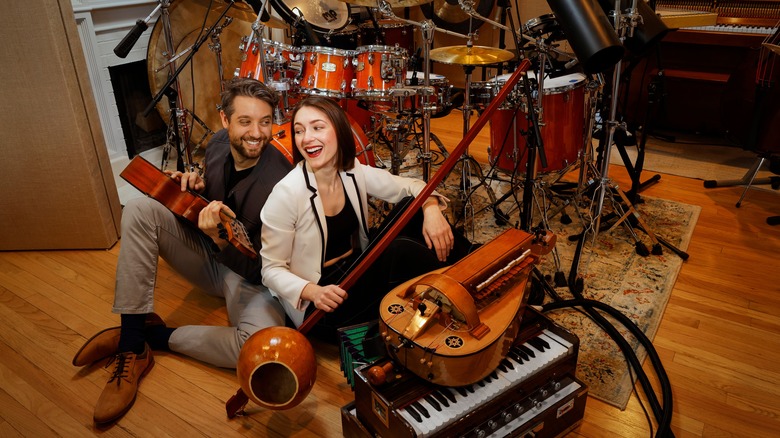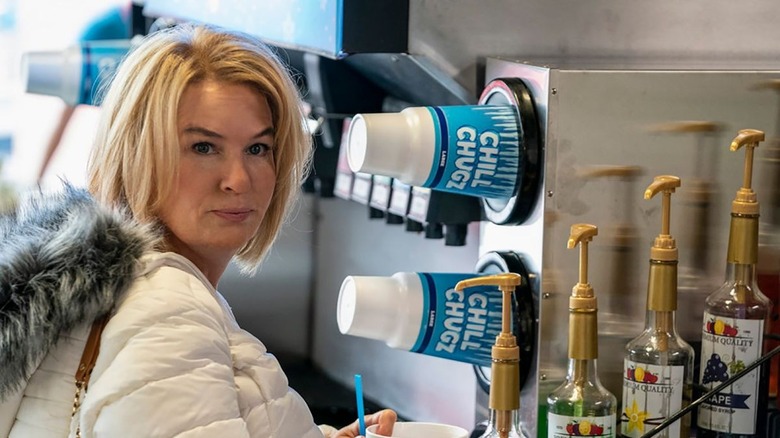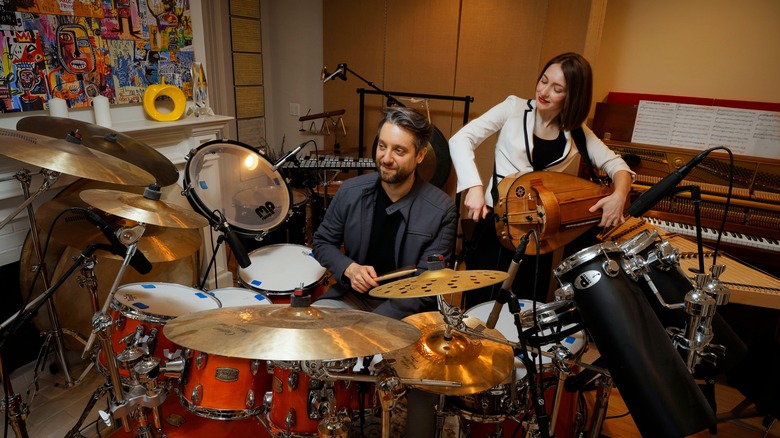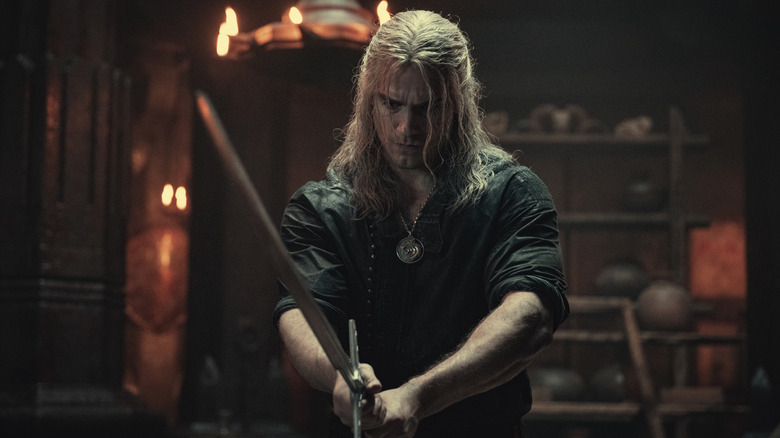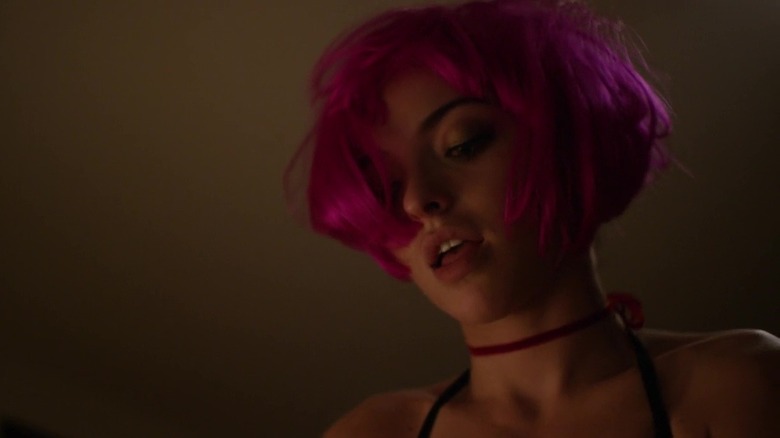Composers Sonya Belousova & Giona Ostinell On Their Career, Ranging From The Thing About Pam To The Witcher [Interview]
It's the end of the week for composers Sonya Belousova and Giona Ostinell. It's a Friday when we speak, but their work is far from over. The composing duo rarely ever stop, and they wouldn't have it any other way. They're the musical duo behind NBC's new series "The Thing About Pam," Amazon's "The Romanoffs," and maybe one of the most listened-to scores of the last few years, Netflix's "The Witcher." They've also scored films that some genre fans will recognize: "Darling," "Like Me," and "M.F.A."
Belousova and Ostinell got range.
They were also accomplished musicians long before composing for film and television. Belousova started playing piano when she was five, made her debut at the St. Petersburg Philharmonia at the age of 8, and at 13, she was the recipient of the Russian Ministry of Culture award. As for Ostinell, he was a natural behind the drums at a young age. Early on in their musical journeys, both knew their interests pointed toward scoring to pictures. Years ago, Ostinell was scoring a David Mamet-produced movie and enlisted Belousova to play piano on it. It was the beginning of their career composing together.
Most recently, they made the eccentric score for an even more eccentric character in "The Thing About Pam." The duo talked to us about their latest work, their beloved score for "The Witcher," and their penchant for experimenting.
"Do we hear slurping?"
"The Thing About Pam," "The Witcher," and "The Romanoffs." Those shows could not be more different. Still, what are you always looking for in scoring a project, no matter the genre?
Belousova: Absolutely. I think we're always looking for the type of project that would require that unique particular sound and unique particular world that would need to be created. Whether it's something like "The Witcher," which is this big, epic fantasy adventure soundscape, or something like "The Romanoffs," which required a very sophisticated delegate gastro palette, or something like "Pam," which is hard to describe because it's so unique and so particular. We're looking for that unique factor.
"The Thing About Pam," like you said, is harder to describe, but how do you try to navigate a tone as varied as that show's?
Ostinell: Well, I think this story is so absurd.
Belousova: It's basically a case of escalating absurdities, which presents a wide creative field for us to explore. On one hand, we cannot forget that this is a true story of real people, of real tragedies. On the other hand, these escalating absurdities provide a weird comedic element in a way because of how wild and crazy and bizarre these events are, which musically presented a fantastic opportunity to explore so many different things, from horror to comedy.
Ostinell: I think the best way to approach it is creating a through line that carries through both comedic and dramatic moments.
Belousova: Musically, everything revolves around Pam as well. Therefore we have this scene that, as Giona mentioned, is basically an arc that carries us through the whole season and develops in different modifications, variations, shapes, forms.
Such as using slurping for music?
Ostinell: Early on we were discussing with Jenny Klein, the showrunner, and she mentioned that Pam always carries with her this big gulp cup and she keeps slurping through the cup.
Belousova: So we're like, "Wait a second. If that's basically like a part of her everyday life, why not make that a part of her soundtrack as well?" And that's how the idea was born. And Giona is a master slurper.
Ostinell: Yeah. "Why don't we put slurping as a rhythmic element?" We tried and it was really cool. Then we sent it over, they're like, "Do we hear slurping?" And we're like, "Yes." They loved it.
Belousova: And that's how slurping became a part of the score. Sometimes it's introduced as a rhythmical element, like a very fast sharp type of slurping. Other times it's that type of prolonged slurping.
Ostinell: I know there are so many different slurping techniques that we are just scratching the surface.
Sonya: And the best part is that it's so incorporated within this score. Sometimes you recognize and hear it, other times it's really a part of the score. It's part of the rhythmical element of the score that you don't even recognize that it is actually slurping, but slurping is all over the score.
I always enjoy hearing from composers just about how they can hear music in so many different sounds or objects. What other strange places have you gone to create an instrument for a score?
Belousova: Well, in this particular one, from the very early stages, one of the things that we discussed with the whole creative team was, "How do we take very simple instruments and twist them into something that they're not?" And that's how the main concept was born about this score. Some of the things that we did, for example, we took an English horn or sometimes an oboe. We transposed that sound a couple of octaves lower. That beautiful, gorgeous English horn sound suddenly becomes this very low menacing, foreboding, sonority.
Ostinell: And the cool thing about this is you think you know the sound like, "Oh, it might be a bassoon or a tuba or trombone." But it is not. You cannot really point your finger at what it is. It makes you a bit unsettled. But at the same time like, I think I know what it is, but I don't know what it is. It leaves you on your toes.
Belousova: We scratched the strings with so many different objects. Well, to start with, we scratch the strings with coins, because Pam's all about the money. Scratching the strings was cool with coins — that felt like the perfect object. Or we threw batteries on the strings.
We plugged them with anything and everything, you name it. Another element that we're using quite a lot is actually a piano pedal, because we needed the driving percussive groove. We were looking for a special percussive element. The piano pedal, it's a percussive sound, but it's not really a singular percussive sound, but it has this resonance around it, which makes the overall sound much heavier and with much more gravitas.
Ostinell: We got this simple mouth harmonica and we are like, "How can we transform this into the most dark and menacing type of sound?" And we started playing around and we were able to transform into a very menacing, low type of texture that was very unsettling.
Belousova: Or another instrument. We actually commissioned an instrument maker to create any instrument specifically for the series, because we're looking for that special element for the cherry on top of the cake. One of the instruments that came up early on in the conversations was a waterphone, but we didn't really want to use a waterphone because it didn't feel unique enough for this show. So we commissioned an instrument maker to create an instrument that would be a combination of a waterphone, with a twist. He came up with this instrument, which is basically a combination of a waterphone and a daxophone.
Ostinell: Pam also had this piggy, saving for Paris. So we were like, "Hey, why don't we use this piggy to create music?
[The duo display two piggy banks over Zoom.]
Belousova: So welcome Piggy and Peggy, which are basically blue peaks that create this super awesome sound. Now imagine when you create a groove out of these sounds, when you place delays and other effects, and then suddenly Piggy and Peggy become this very uncomfortable scratching. That's the part of the overall growth, when in fact it's Piggy and Peggy.
"We started experimenting with different instruments quite a lot on 'The Witcher'"
Do you two often commission instruments to be made if you're not getting what you want out of a certain instrument?
Belousova: I don't think it comes from the place of not getting what we want from an instrument. It comes from a place of, what else can we do?
Ostinell: Not only that, but it's like getting inspired by an instrument, like something new. How can we get something new that is going to be like, "Oh, we can try this. We can try this or that or we have never tried before." And that consequently is going to give you new ideas, come out with some cool things.
Belousova: We started experimenting with different instruments quite a lot on "The Witcher." Because beyond all the soloist ensembles that we recorded, just between the two of us, we recorded over 60 instruments from hurdy-gurdy to harps, any like historical instruments, berimbau, you name it. It got us inspired to experiment with different instruments, especially different unfamiliar and not so popular instruments.
We commissioned another instrument maker to create a berimbau for us. Berimbau originally is a Brazilian instrument, and it cannot be tuned. With that said, this maker was able to create a tunable berimbau, which was so cool for us because we could tune it left and right and do really cool things. So that's really when we started diving into all these instruments and experimenting with instruments. Every instrument can give you so many different possibilities to explore. As Giona said, you really get inspired. So all of that comes from a place of, how else can we do some cool things? What other cool sounds can we explore?
Ostinell: Not only that, but it's also like the creators, showrunners, directors, producers, the actors, they put so much time and creativity in making their character particular and memorable. And we're like, how can we make the score? How can we add an element that is going to be that particular element that's going to be a particular score and make it distinguishable from anything else? We do strongly believe the score is always strongly melody-driven. So you can remember it, but then sparkling on top these unexpected elements.
Belousova: And that's really the thing about these scores. Very melody-driven. And despite all these crazy instruments and crazy techniques that we're incorporating, at the end of the day, it is a very kind of mainstream score. It's a very listenable score. There are melodies and it's very melody-driven. However, then we chose to surround this melody with all these instruments and all these interesting techniques as cherries on top of a cake.
How do you experiment with an instrument as simple as a harmonica?
Ostinell: You just grab it and start messing around, and that's the beauty of not being able to play an instrument. I'm not a great harmonica player. I'm really bad at it, but you start approaching maybe in the wrong way, and you're like, "Oh, this is cool." We did rhythmic elements with harmonica. We're doing all those breathing techniques.
Belousova: There is like a breathing rhythmical element on a harmonica that we have that we enhanced with various effects and terminators. So from just a breathing type of harmonica, that becomes a very anxious, groovy element. Again, there are so many possibilities that you can explore with instruments.
Ostinell: For example, on "The Witcher," we got a Contrabass. Neither of us plays Contrabass, but we started experimenting. What can we do?
Belousova: We, in fact, invented the technique called Contrabass four hands. The reason why it became a Contrabass four hands is it actually takes us a lot of muscle strength to hold the string. Now, there are instruments that we are very proficient in, whether it's drums and percussion for Giona or piano for me, especially being a concert pianist.
With that said, you don't always necessarily need to be a virtuoso with a specific instrument. It shouldn't prevent you from being able to pick up an instrument, learn the basics of that instrument and learn how to get cool interesting sounds and textures from that instrument. Obviously, if we need, let's say a violin solo, we're going to call our violinist. With that said, there are so many things that you can do. And that's why we love having instruments in the studio, because that inspires us so much.
"It's an electric guitar with a very special medieval flavor"
You both clearly have a lot of love for a wide range of instruments. What are some deep cuts for you both? Instruments that maybe aren't popular, but you get a lot out of with your scores?
Belousova: Well, hurdy-gurdy, of course. Hurdy-gurdy. We started experimenting on hurdy-gurdy on "The Witcher," actually. That was my first experience playing a hurdy-gurdy. It turned out to be so much fun because, surprisingly, it's such an incredibly versatile instrument because hurdy-gurdy originated in medieval Europe. Originally it was used to accompany dances. On "The Witcher," there are a couple of scenes and a couple of cues where we use a hurdy-gurdy in its most traditional sense, accompanying dances. Turns out there is much more that instrument is capable of and we experimented with it so much.
If you apply some distortion to it, it sounds like an electric guitar, and I'm not even kidding. Literally has that electric guitar sound. With some buzzing medieval edge to it. Put a distortion on a hurdy-gurdy and there you go, it's an electric guitar with a very special medieval flavor. So, my personal favorite is a hurdy-gurdy, of course.
Ostinell: I cannot wait to start hearing some rock metal bands coming out from Germany with some hurdy-gurdy player doing crazy stuff. I cannot wait for that moment.
Belousova: Which ones are your personal favorites?
Ostinell: I got many.
Belousova: Yeah. I don't think it's necessarily always about a personal favorite, it's about what instruments would be an appropriate instrument for a particular score that we're working on and what are the cool things that we can do with it?
What's a typical workweek schedule for you both?
Belousova: Our schedule is 24/7.
Ostinell: We don't usually take breaks. We work from Monday to Sunday. And then we start again on Monday. We enjoy this. We don't feel it as work. It's a lot of fun for us and we enjoy it tremendously. And we start in the morning around nine or 10 and we keep going.
Belousova: Giona usually gets to the studio earlier, so he can start earlier. I'm a night owl. I have always been and always will be. I usually get to the studio by 11-ish and then we keep working. Depending on the project that we're on, it can be anywhere until closer to midnight. Sometimes even later, like "Witcher" was especially crazy because the post-production offices were in London. Giona would leave around midnight or one. I would stay up later for the whole correspondence with London. I would stay up until maybe four or five, maybe sometimes even later, depending on how crazy it'd get. So this is a typical day for us, Monday to Sunday. We're loving this.
When you're working on a show as big as "The Witcher," how do you try to musically help create that sense of scale?
Belousova: "The Witcher" is a tricky one. We have eight episodes in the first season. Every episode is one hour in length, and every episode features pretty much one hour of music. It's a lot of music not only to write, but also for an audience. It's a lot of music to go through within one show. The conversation that we had from very early on is, how to organize that massive amount of music and how to create a very logical and cohesive soundscape? And this is when coming on board very early comes in super handy, because then you can start creating thematic suites.
From "The Witcher," it was essential for us to create the thematic suites, the strong themes that would go along together with each character. That's when we created the theme for Geralt, the theme for Ciri, for Yennefer. This was even long before they even went into production or before we even started working on this picture. The thematic material was created. So then when we finally received the picture and started working to picture, it was more about applying these [themes] and structuring it logically throughout the scope of the season. So this is how you deal with this massive epic action-adventure type of soundscapes.
Ostinell: I think it does apply for pretty much every project. With "Pam," it was the same process that we applied. We came on board early on before they started shooting. We started by writing thematic suites. It's just great because then you already have the theme that everybody loves, that everybody's familiar. And then when you get to start working on the episodes to picture, you can just start organizing, planning the themes, and how they're going to develop throughout the arc of the season. "Pam" is the same thing. We start introducing the themes in the first episode, and they keep developing up to episode six as Pam's character develops.
Belousova: This approach is really great, because instead of first you work on episode 1, then you work on episode 2 and then when you're on episode 5, by this point episode 1 and 2 are wrapped and then you come up with something really cool. And then you're like, "Oh, I wish I could have incorporated that in earlier episodes." We don't have this problem, because we start very early on, and we have so much thematic materials. So in this case, we can plan ahead. We already know how they seem to develop in episode 5 and the type of things that we would do in episode 5 that we can bring in earlier episodes and plan those seeds.
Ostinell: For example, we had the main theme, but then we wrote several variations like a more dramatic version, a more suspense version. For the picture editor, we provide them all these suites and they can start placing a bit of the music and see what works, what doesn't work, and keep going from there.
Belousova: In fact, on "Pam," there was no temp score. We were providing the actual score right away.
Ostinell: For the picture editor, they really enjoy this way because they don't have to worry about finding a piece of music that works for the scene. They would call us up and they're like, "Hey, we have to send back the picture to the studio for notes. We have this scene, we cannot find anything. Can you write something?" We're like, "Yeah, absolutely." They will send us the scene and we just tackle, send it back to them. They would love it because it's already pretty much the final music. They don't have to spend time looking for music, going through music.
"The first time we started experimenting with vocals"
When did you two start using vocals for your scores? When do you know it'll enhance the score and picture?
Belousova: Vocals are something that happened very naturally. We first started experimenting with vocals and with writing songs on "Sacred Lie” in the first season, no?
Ostinell: "M.F.A." was the first approach to vocals in a different way.
Belousova: There was "M.F.A.," which was a really cool indie film that we did, I think in 2016. You're right, that was the first time with vocals.
Ostinell: And the way that happened is Francesca Eastwood, she's the main character. And I don't know if you ever heard her talking, but she has a wonderful –
Belousova: Oh my goodness. Her voice. I fall in love with voices. I just fell in love with her voice immediately because she has this super low, very rich and deep voice.
Ostinell: We were writing and we watched a bit of the movie, and we heard her talking. And we're like, "Oh my gosh, her voice is so melodic. So great. Why don't we incorporate it in the score?" So we sampled some of the phrases that she was saying, and we put them in the score. It was working great.
Belousova: And that was the first time we started experimenting with vocals. Then came "Sacred Lies." The thing about "Sacred Lies" is the story revolves around teenagers, right? So we needed this cool, hip element. Songs and vocals are just something that came naturally, because we wanted to write several songs for the show. However, with that said, we didn't want them to be standalone, separate songs. We wanted them to be the type that would be incorporated in the score.
It would embrace the overall sonority and soundscape of the score. So we did several songs for "Sacred Lies” and we'll throw in the lyrics for those songs. And then comes "The Witcher." It is where we started experimenting with songs because of Jaskier, who is one of the characters in this series. He is in a bar and sings and then comes "Toss A Coin To Your Witcher." It's still unbelievable to me that the song came out and suddenly we're trending number one on Billboard.
Not only number one on Billboard, but number one on Billboard rock songs. I think all of us when we saw those charts that day, I think all of us went like, "Wow." So "The Witcher" was such an amazing opportunity to dive into the songs and make the songs an essential part of the overall soundtrack.
Quickly back to "Toss A Coin To Your Witcher," that happens at the very end of episode 2 in "The Witcher" in season 1. With that said, the thematic material of the song gets introduced in the score, very, very early on in episode 2. So in this sense, the song appears at the end, but the audience unconsciously starts hearing the theme of the song from very early on in the episode. By the time the song appears, yes, it's brand new material, but at the same time, it feels strangely familiar when we have been developing these scenes throughout the whole episode. So then when it comes at the end, it's an overall climax of the whole music in this episode, it all leads to this song at the end. We also incorporate vocals, not just for songs or lyrics, but we also like incorporating them as a melodic instrument a lot of times.
It just really felt like in "The Witcher" that just having songs was not enough; it needed that lyrical vocal component. I performed all the vocal parts on "The Witcher. " There is this track that all the fans love, "Tomorrow I'll Leave Blaviken For Good." There is the vocal part, so it was me singing that one. [She sings it beautifully] It was just asking to be a part of that world and we had to do it. So that's how that happens. I won't spoil anything, but there might be some more songs related coming out soon-ish. That's all I can say for now, but like, I've been dying about this for the longest time and I cannot wait for the moment when I can officially talk.
Giona, I couldn't help but notice you didn't sing along.
Ostinell: [Laughs] Let's just say that my vocals need a lot of treatment.
Belousova: Your vocals are great.
Ostinell: Yeah, sure. I do some parts in "The Witcher," but they're hidden underneath other instruments. Under which I was doing a lot of the breathing, action type of things, like this type of breathing that after a while gives you a headache because you hold air. But she's a much better singer than I am.
